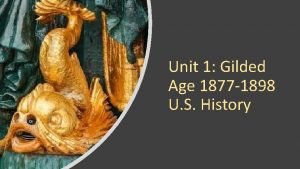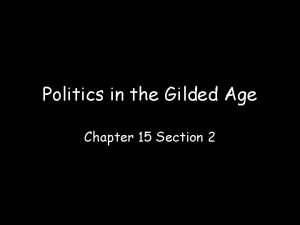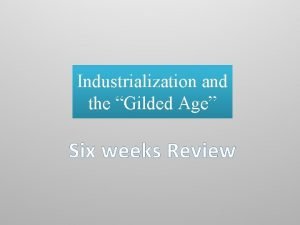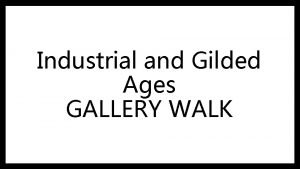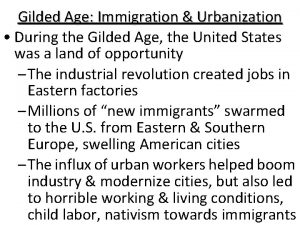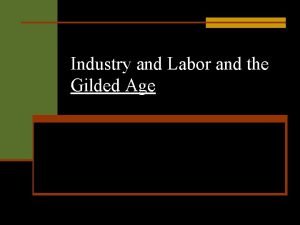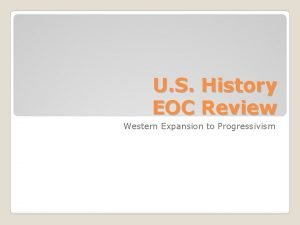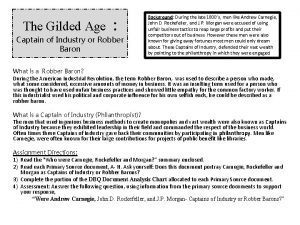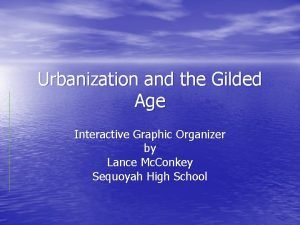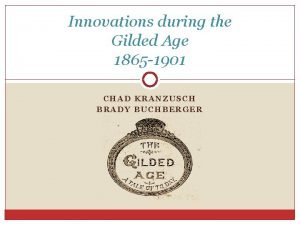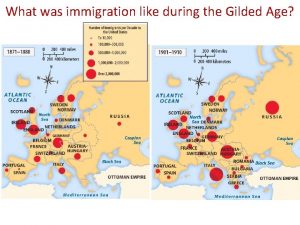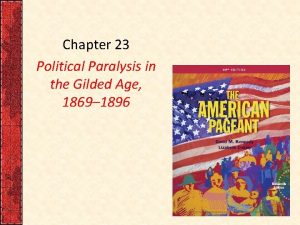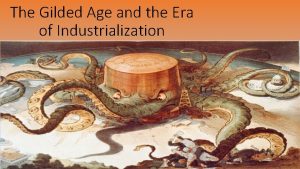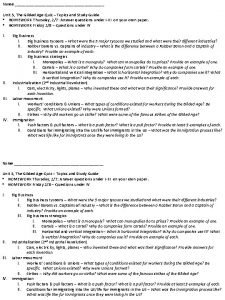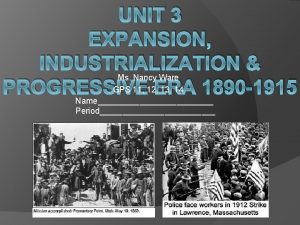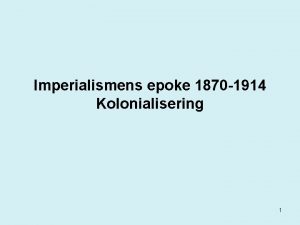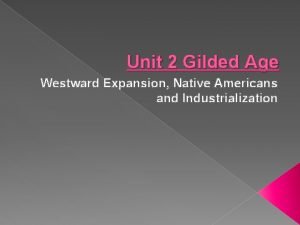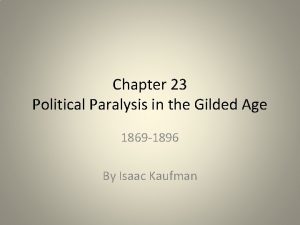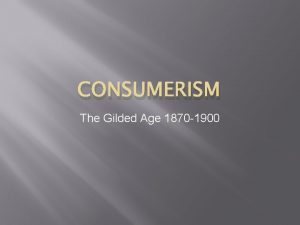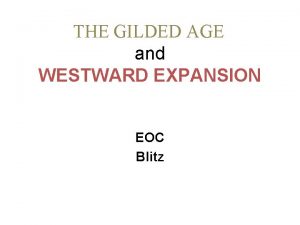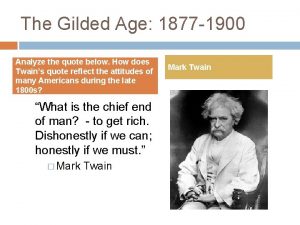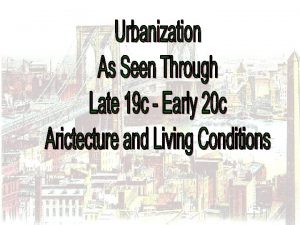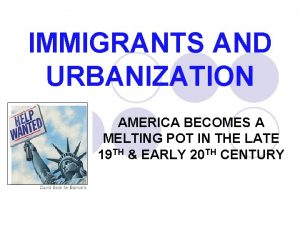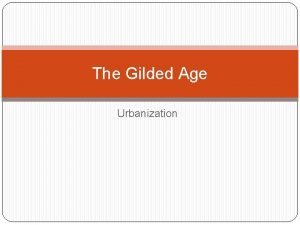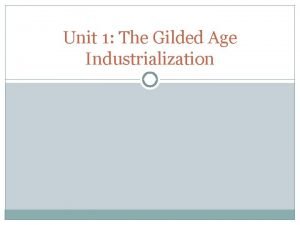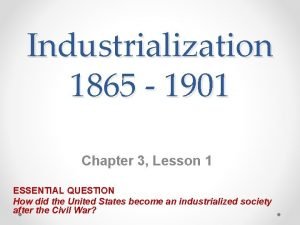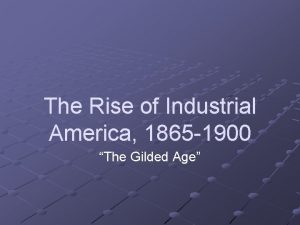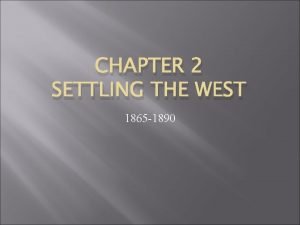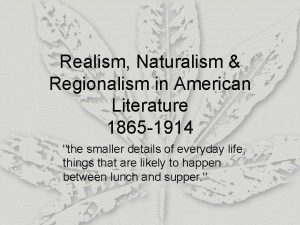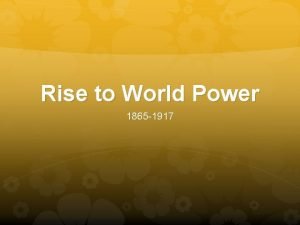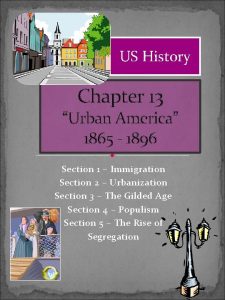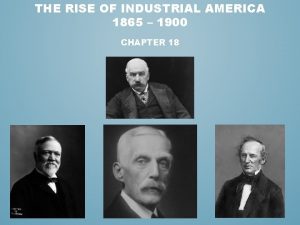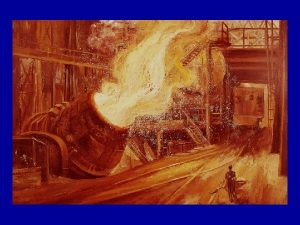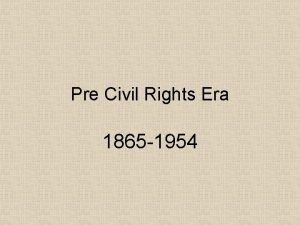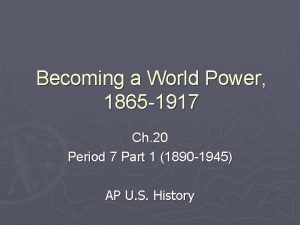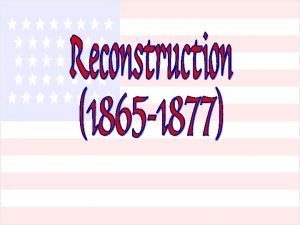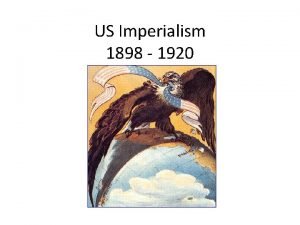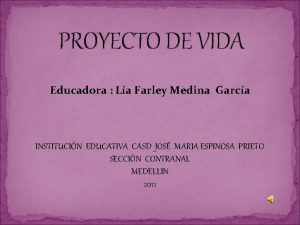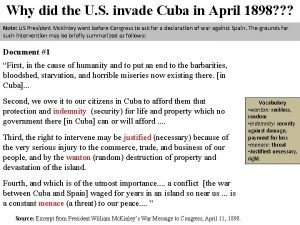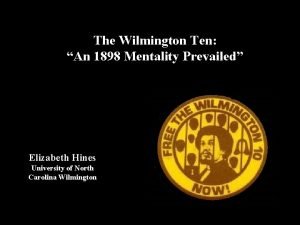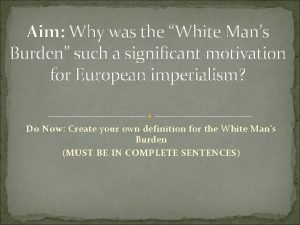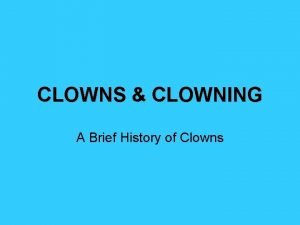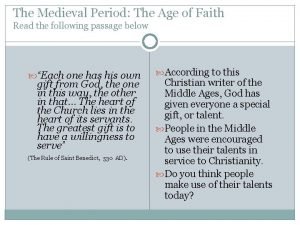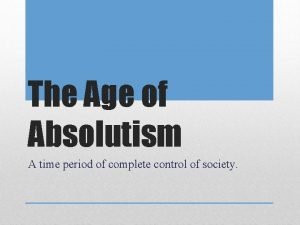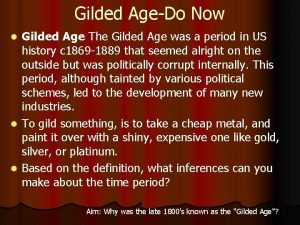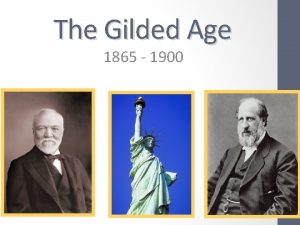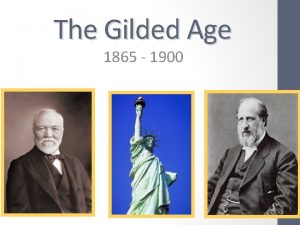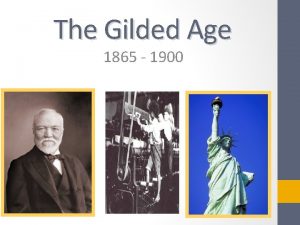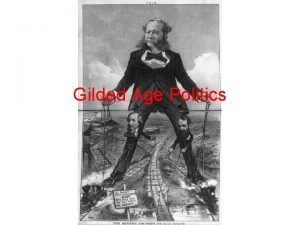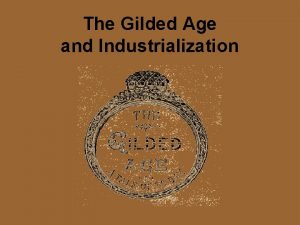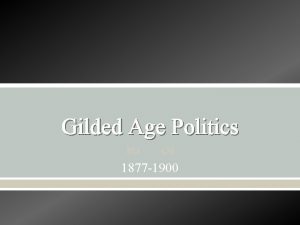THE GILDED AGE PERIOD 6 1865 1898 Mr





























































































- Slides: 93

THE GILDED AGE PERIOD 6: 1865– 1898 Mr. Richardson, MAT GHHS

GILDED AGE • Big business boomed in the United States, starting the Gilded Age—when consumption was king—and sparking major migration and urbanization. New efforts grew to revamp the country's economy and environment. As always, people were talking about what the country's identity should now be like in this fast-changing time. • The new industrial culture created new opportunity for women, minorities, and crowds of immigrants, but new restrictions, too. • The Gilded Age wasn't just about guilders. Cultural and intellectual movements blossomed during this time, along with political arguments over policies affecting society and the economy.

PRODUCTION AND THE GILDED AGE Thematic Learning Objectives • • Work, Exchange, and Technology: Explain how changes in transportation, technology, and the integration of the U. S. economy into world markets have influenced U. S. society since the Gilded Age. • Work, Exchange, and Technology: Explain how arguments about market capitalism, the growth of corporate power, and government policies influenced economic policies from the late 18 th century through the early 20 th century. • America in the World: Explain how the growing interconnection of the United States with worldwide economic, labor, and migration systems affected U. S. society since the late 19 th century. • Ideas, Beliefs, and Culture: Explain how cultural values and artistic expression change in response to the Civil War and the postwar industrialization of the United States. • Ideas, Beliefs, and Culture: Analyze ways that philosophical, moral, and scientific ideas were used to defend and challenge the dominant economic and social order in the 19 th and 20 th centuries.

• We have Mark Twain to thank for the term "Gilded Age. " • The title is apt for the period. Things that are gilded shine with a gold coating, but there's no gold inside. • The industrial titans of the Gilded Age nabbed the nuggets. The little farmers and factory workers often found life hollow. Consider the shine and the hollow.

• According to the Library of Congress, 45, 000 miles of track had been built before 1871. • Between 1871 and 1900, the railroad network added 170, 000 more miles. • The first transcontinental railroad was finished on May 10, 1869, four more followed by 1900. • Subsidies through Land Grants opened new markets

TECHNOLOGY IN THE GILDED AGE • Alexander Graham Bell patented the telephone in 1876 • The federal patent office granted 440, 000 patents between 1860 and 1900, which was twelve times as many as in the 70 years that came before. • Other innovations during this time included Thomas Edison's light bulb, the cash register, the typewriter, the Bessemer blast furnace, the refrigerated boxcar, and new techniques for refining oil

GROWTH OF CORPORATIONS • Industrialists realized that they could minimize the risk by joining together. • Forming cartels or pools with former competitors in the same industry, they created "gentlemen's agreements" on what the acceptable price range or production level would be for a type of good.

EXPANSION • Even as Americans flew westward on trains, politicians were looking east…and farther west…and south. • Secretary of State Seward bought Alaska in 1867

EXPANSION: HAWAII • Hawaii was a great producer of sugar cane and not a bad market for manufactured goods. • Important way station for trade between the U. S. and Asia. • U. S. businessmen basically took over the whole economy in the 1870 s, overthrew the monarchy and the U. S. annexed the republic.

SPANISH-AMERICAN WAR • With the end of the Spanish-American War, the U. S. took control over the Philippines, Puerto Rico, and Guam. Sorry, Spain. • Trade with Japan had continued to expand ever since Commodore Perry's mission to Japan in the 1850 s

BUSINESS LEADERS AND SOCIAL DARWINISM • Business leaders in the late 1800 s started consolidating corporations into larger beasts: holding companies, which owned other companies' stock and controlled them; and trusts, which acted as agents for people or other business entities.

ROCKEFELLER • Head of Standard Oil Company. When he formed the company in 1868, it processed 5% of the country's oil. • Rockefeller built a monopoly by making secret contracts with the railroads that allowed him to ship oil at a lower cost, which let him sell oil at a lower price than his competitors • By the mid-1880 s, he

J. P. MORGAN • Morgan controlled the railroads, because he owned most of them. He also turned General Electric into an industrial conglomerate by forcing through a merger

THE COMMON MAN • Unskilled industrial workers pulled in an average of 10 cents an hour working 60 hours a week. At home, people were packed into crowded tenements with terrible ventilation and worse plumbing • Ask a titan about all the poverty afflicting America's 75 million people, and he might say, "That's nature. " The theory of Social Darwinism was popular among the giants in these times. It stated that the strong thrive and the weak fall through the cracks. If people were poor, a Social

CONSPICUOUS CONSUMPTION • The Gilded Age was like a gold coin. On one side, the Morgans and the Rockefellers and the conspicuous consumption were buying things just to show them off. On the other side, workers lived the hard-knock life in the slums. • Journalist Ward Mc. Allister focused his pen on the rich, documenting the opulence of their lives.

CONSPICUOUS CONSUMPTION • Jacob Riis was a social reformer as well as a journalist, and his photographs and writings centered on letting the world know about the poverty in New York City. Famous for recording crime in alleys, small lives in pitiful slum apartments, and children forced to slave away in factories. He was one of the first users of flash photography, useful in tenements without electricity. • Riis published many of his photographs and writings in How the Other Half Lives: Studies among the Tenements of New York in 1890. After its publication, many tenements and sweatshops in New York City were torn down. Some improvements in sanitation, such as sewers and garbage collection, also followed.

UNIFIED INDUSTRIALIZED NATION • Work, Exchange, and Technology: Explain how and why different labor systems have developed, persisted, and changed since 1800 and how events such as the Civil War and industrialization shaped U. S. society and workers' lives. • Work, Exchange, and Technology: Explain how arguments about market capitalism, the growth of corporate power, and government policies influenced economic policies from the late 18 th century through the early 20 th century. • Work, Exchange, and Technology: Compare the beliefs and strategies of movements advocating changes to the U. S. economic system since industrialization, particularly the organized-labor, Populist, and Progressive movements. • Peopling: Analyze the role of both internal and international migration on changes to urban life, cultural developments, labor issues, and reform movements from the mid-19 th century through the mid-20 th century. • Identity: Analyze the role of economic, political, social, and ethnic

INDUSTRIAL WORKFORCE • Immigrants weren't coming mainly from Germany and Britain but from southern, eastern, and central Europe. Second Wave Immigration yielded a massive new workforce for industrial America, with five million people arriving in the 1880 s alone. • Cities soared in population during the Gilded Age. By 1900, city-dwellers made up 40% of the country's population, as opposed to 20% in 1860.

INDUSTRIAL WORKFORCE Immigration made the workforce more diverse, as did the many African Americans who moved from the South to the industrialized North in the 1870 s. That's where the jobs were, and no one could blame black Americans for wanting to leave the plantation states where

INDUSTRIAL WORKFORCE Child labor was a disgrace that lasted far too long in this country. It wasn't until 1916 that the first child labor bill, the Keating-Owen Child Labor Act, was passed. The Supreme Court then ruled it unconstitutional, so kids had to wait until 1938 for the Fair Labor Standards Act, which also had to survive a

LABOR AND MANAGEMENT • Mother Jones • Jones was one of many labor activists and organizers who clashed with industry managers and factory owners. They agitated for safer working conditions and decent salaries. They had to be brave as they fought the power at the risk of losing their livelihoods. Meanwhile,

LABOR AND MANAGEMENT • One of the first major unions was the Knights of Labor • From its founding in 1869 through its heyday in the 1880 s, the group pushed for an eight-hour workday, the abolition of child labor, the graduated income tax, and equal pay for equal work.

LABOR AND MANAGEMENT • The American Federation of Labor also popped up in the 1880 s. • The AFL would later merge with the Congress of Industrial Organizations to form the AFL-CIO, which today is still the biggest federation of unions in America.

LABOR AND MANAGEMENT • Strikes and other actions could turn violent. The Great Railroad Strike of 1877, in which workers all over the country walked off their jobs and made the trains stop running, might have seemed like a success until federal troops started shooting and bloody riots broke out. • The Knights of Labor weren't the same after the 1886 Haymarket Riot, where someone tossed a dynamite bomb at the police during a rally in support of workers striking for an eight-hour day. At least 11 people were killed, and the Knights never recovered from the headlines.


THE SOUTHERN ECONOMY • Bits of the South got the industrial fever, but slowly. Many people focused on returning their scorched-earth farms back to normal after the war, and the agricultural focus continued. • Sharecropping would thrive for decades after the Emancipation Proclamation, along with other tenant farming systems in which workers did not own their land but labored away on farms owned by others, paying all kinds of rent or portions of crops.

THE SOUTHERN ECONOMY • The ongoing agricultural focus disappointed Southern leaders who were calling for more industrialization. Their vision of a "New South" was distinct from the mired-in-the-past antebellum systems. These leaders looked at the post-war South and saw a region still lagging far behind the industrialized North: impoverished and reliant on crops that didn't bring in a lot of money.

THE SOUTHERN ECONOMY • Leaders dreamed that the "New South" could be a region on the rise, bustling with commerce and making a place for free African Americans. At the very least, this new version should be a place that didn't depend solely on cotton, so there was a push to grow more rice, sugar cane, and tobacco and to export coal, iron, and lumber.

THE SOUTHERN ECONOMY • Georgia journalist Henry W. Grady was one of the most public speakers on the "New South" vision. He dreamed of prosperity for his region and advocated the creation of the Georgia Institute of Technology. Today, the journalism school at the University of Georgia is named after him.

POLITICAL AND POPULAR CONFLICTS

THEMATIC LEARNING OBJECTIVES Environment and Geography—Physical and Human: Explain how and why debates about and policies concerning the use of natural resources and the environment more generally have changed since the late 19 th century. Work, Exchange, and Technology: Explain how and why different labor systems have developed, persisted, and changed since 1800 and how events such as the Civil War and industrialization shaped U. S. society and workers' lives. Work, Exchange, and Technology: Compare the beliefs and strategies of movements advocating changes to the U. S. economic system since industrialization, particularly the organized-labor, Populist, and Progressive movements. Politics and Power: Explain how activist groups and reform movements, such as antebellum reformers, civil rights activists, and social conservatives, have caused changes to state institutions and U. S. society. Peopling: Analyze the causes and effects of major internal migration patterns such as urbanization, suburbanization, western movement, and the Great Migration in the 19 th and 20 th centuries. Peopling: Explain how free and forced migration to and within different parts

EFFORTS V. CORPORATE INTERESTS • People were realizing that just because the American frontier seemed endless didn't mean that it actually was. Someday, factories would run out of rivers to dump green sludge into. Luckily, the late 1800 s coincided with the birth of the green movement.

EFFORTS V. CORPORATE INTERESTS • Corporations wanted to do business in the most efficient and most profitable way, but sometimes that meant dumping green sludge into rivers rather than taking the time to clean it up. • Many people decided that it was the government's role to stop the sludge dumping by taking an active role in regulating business practices. Others formed organizations to protect the environment themselves.

EFFORTS V. CORPORATE INTERESTS • People were already noticing a decline in fish in and around the United States in the 1800 s. The U. S. Fish Commission, one of the earliest government bodies founded to defend the environment, was born in 1871 after an independent commission started investigating the decline.

EFFORTS V. CORPORATE INTERESTS Even larger was the U. S. Department of the Interior. When it was established in 1849, the department handled pretty much everything in America that wasn't treasury, war, law, foreign policy, or delivering postcards.

EFFORTS V. CORPORATE INTERESTS • A big part of the department's power was performing geological surveys of new territories and protecting large chunks of them. It established the first national park, Yellowstone, in 1872, and the U. S. Geological Survey in 1879. • Nature-lover and explorer John Muir was among the determined circle of men who met in San Francisco in 1892 to found the Sierra Club.

AGRICULTURAL MARKETS • Shortly after the Civil War, the Grange (or the National Grange of the Order of Patrons of Husbandry) started up in 1867. It was—and is—an American fraternal organization that brought farming families together to strengthen communities and advocate for farmers' interests. • Grange causes included working for government regulation of how grain elevators were run. Those companies just kept raising the prices they charged farmers—until the Grange got Granger Laws passed to regulate prices in the 1860 s-70 s.

AGRICULTURAL MARKETS Another agricultural organization that emerged at this time was Las Gorras Blancas. Mexican Americans in the Southwest banded together in the 1880 s and '90 s to defend their lands from being seized by the influx of white settlers. Members of Las Gorras Blancas protested in ways ranging from burning barns and staging demonstrations to running for public office. Three were elected to state offices in New Mexico, but they couldn't garner a lot of support in the legislature for their cause.

AGRICULTURAL MARKETS • The Colored Farmers' National Alliance and Cooperative Union focused on making life better for African-American farmers. Founded in Texas in 1886, the group sought to protect members from horse thieves, land-grabbers, and the increasing costs of farming life. • Members worked to educate other farmers about modern agricultural techniques that could bring in more crops. Their main goals were to help all black farmers be financially selfsufficient, preferably via owning homes and

CREATION OF THE POPULIST PARTY • With corporations on the rise, farmers had enough to worry about. Too bad agriculture was also teetering. Crops were failing and prices were dropping, especially for Southern cotton. Farmers had trouble getting credit. To make everything even more of a muddy mess, a drought clamped down on the Midwest in the 1880 s.

CREATION OF THE POPULIST PARTY • Farmers harbored heavy resentment against moneylenders and railroad-runners. They called on the government for help. The Granger Laws were a good start, but they weren't enough. In 1891, an angry group of agriculturalists started the People's (Populist) Party, a political party with a following among poor white Southern cotton farmers and midwestern wheat farmers. • More government, please, the Populists said. Get in here and regulate the corporations and banks that are sitting on us. Aid poor farmers. Above all, listen to us.

CREATION OF THE POPULIST PARTY • Election Day 1892 would live on in Populist history. That's the day the party won several congressional and gubernatorial seats, as well as local elections. It also eked out more than a million votes for its presidential candidate, James B. Weaver. Was it a revolt? Marketing departments said it was. The Populists also had some success in making alliances between white and black farmers in the South

CONSERVATION AND PRESERVATION • Early conservationists weren't known for moving into trees, but they did have some victories other than getting national parks approved. In 1891, Congress passed the Forest Reserve Act, which allowed the president to "set apart and reserve" forest lands that were located in public areas. The timber industry, of course, was less than thrilled.

CONSERVATION AND PRESERVATION That act paved the way for President Theodore Roosevelt to establish the U. S. Forestry Service in 1905. Old Teddy would gain a reputation as quite the conservationist, signing bills that established five national-park areas and four national monuments. He also put a big part of the Grand Canyon under government preservation. According to the National Park Service, the country's forest reserves went from

INEQUALITY AND REFORM

THEMATIC LEARNING OBJECTIVES • Identity: Analyze how migration patterns to, and migration within, the United States have influenced the growth of racial and ethnic identities and conflicts over ethnic assimilation and distinctiveness. • Peopling: Explain how changes in the numbers and sources of international migrants in the 19 th and 20 th centuries altered the ethnic and social makeup of the U. S. population. • Peopling: Analyze the causes and effects of major internal migration patterns such as urbanization, suburbanization, western movement, and the Great Migration in the 19 th and 20 th centuries. • Peopling: Analyze the role of both internal and international migration on changes to urban life, cultural developments, labor issues, and reform movements from the mid-19 th century through the mid-20 th century. • Politics and Power: Explain how activist groups and reform movements, such as antebellum reformers, civil rights activists, and social conservatives, have caused changes to state institutions and U. S. society.

MIGRATION, AND URBANIZATION • In the late 1800 s, New York City earned a reputation as the "Golden Door" because so many immigrants entered through it— as many as 70% of all newcomers to the nation. Emma Lazarus used the phrase in her poem "The New Colossus, " which she wrote to help raise the money to build the Statue of Liberty. It includes these famous lines: • "…Give me your tired, your poor your huddled masses yearning to breathe free, the wretched refuse of your teeming shore. Send these, the homeless, tempest

DIVISIONS IN URBAN CITIES • By 1910, the U. S. Immigration Commission would report that more than half of the workers in the industries it examined were immigrants. Numbers were higher in some industries like railroads, the coalmines of Pennsylvania, and the garment factories of New York City. People lived, worked, and socialized with others of their own classes, cultures, races, and ethnicities. • These divisions were all the more dramatic because the types of immigrants had changed. Newcomers to America in the mid-1800 s were more educated and skilled, bringing advantages along in their suitcases. Those in the late 1800 s fled poverty and religious persecution back home. They were often unskilled, so the jobs open to them in the new industrial world were

“AMERICANIZATION” OF NEW IMMIGRANTS • Automobile pioneer Henry Ford had a feeling about immigrants. It wasn't cozy or fluffy. • Ford took it as the gospel truth that everyone in this country needed to blend in. Starting in 1914, all immigrant workers in his auto plants had to attend "Americanization" courses, where silly native customs like religion were verboten, and English grammar and Ford's conservative beliefs were promoted.


“AMERICANIZATION” OF NEW IMMIGRANTS • Against the odds, many immigrants persevered through the social prejudices against them that seemed to be everywhere. They had to fight to succeed, like African Americans and women. Often, success meant giving up the accent and pretending to believe what the boss believed. • There are numerous stories of immigrants coming from nothing, living in the slums of American cities, and then making one business idea work. Turn-ofthe century newcomers who succeeded included Jewish immigrants Samuel Goldwyn, Louis Mayer, and Harry Warner. They went to Los Angeles and

“AMERICANIZATION” OF NEW IMMIGRANTS • A Chicago bank, for example, might have all Polish-American clients or cater exclusively to Jewish families. Look at A. P. Gianinni. That little Bank of Italy he founded in San Francisco in 1904 was a boon to small business owners and humble laborers from his community of Italian immigrants. Eventually it turned into Bank of America.

SETTLEMENT HOUSES, AND URBAN REFORM • Political tyrant William H. "Boss" Tweed, ran New York City politics with an iron fist from his headquarters on East 14 th Street. Even as his men were serving minestrone to new immigrants, they were also handing out political leaflets and telling them in no uncertain terms to vote for Tweed-approved candidates.

SETTLEMENT HOUSES, AND URBAN REFORM • Political machines like Boss Tweed's Tammany Hall, a nickname for his HQ, were rife with bribes and kickbacks that flowed through the door in exchange for city contracts. Tweed controlled

SETTLEMENT HOUSES, AND URBAN REFORM • Even true reformers often tried to "Americanize" immigrants at the same time. Jane Addams, a college-educated Chicagoan, was an avid suffragist and an even more active worker for immigrants. With some allies, she started the settlement-house movement to provide safe places for immigrants to hang out, like her Hull House, an old mansion that the group renovated. • In 1931, Addams was awarded the Nobel Peace Prize, the first American woman to win the award.

SETTLEMENT HOUSES, AND URBAN REFORM • Women's rights were also a hot topic in the late 1800 s, with Elizabeth Cady Stanton and Susan B. Anthony starting the National American Woman Suffrage Association. Besides pushing for women's right to vote, this group brought back together the suffrage groups that had suffered a falling-out over whether to support the Fifteenth Amendment.

SETTLEMENT HOUSES, AND URBAN REFORM • Founded in Cleveland in 1874, the WCTU spoke out about how alcohol tore families apart and wreaked violent havoc on communities. The women carried signs with catchy slogans like, "Lips that touch liquor shall not touch ours. " Carrie Nation, who started a branch of the organization in Kansas, was better known for smashing up bars with her hatchet.

RAILROADS AND INTENSIFYING WESTWARD MIGRATION

THEMATIC LEARNING OBJECTIVES • Peopling: Analyze the effects that migration, disease, and warfare had on the American Indian population after contact with Europeans. • Environment and Geography—Physical and Human: Explain how and why debates about and policies concerning the use of natural resources and the environment more generally have changed since the late 19 th century. • Politics and Power: Analyze how debates over political values (such as democracy, freedom, and citizenship) and the extension of American ideals abroad contributed to the ideological clashes and military conflicts of the 19 th century and early 20 th century.

WESTWARD MIGRATION AND VIOLATION OF NATIVE AMERICAN TREATIES • Economic opportunities in the West were irresistible. The federal government had already given subsidies to the railroads. Now it started handing out plots of land to the western states and others for the noblest cause of all: education.

WESTWARD MIGRATION AND VIOLATION OF NATIVE AMERICAN TREATIES • The Morrill Land-Grant Acts of 1862 and 1890 were big men on campus in the university world. These 19 th-century stars gave land that had been controlled by the federal government to the states. Then, the states would sell the land to raise money for creating "land-grant" colleges with an emphasis on teaching agriculture, engineering, and science.

WESTWARD MIGRATION AND VIOLATION OF NATIVE AMERICAN TREATIES • The 1890 act focused on the former Confederate states and promoting notions of racial equality. To get federal land through this act, a state had to show that the college wouldn't make admissions decisions based on race— or it had to create a separate land-grant college for people of color. (They almost had us fooled until that separate-butequal bit. )

COMPETITION AND CONFLICT IN THE WEST • Western wars between whites and Native Americans raged particularly intensely. According to the Smithsonian Institution, a thousand people were killed in these wars between 1866 and 1890, and 106, 000 troops were involved. The Lakota chief Sitting Bull reportedly asked, "If the white men take my country, where can I go? "

COMPETITION AND CONFLICT IN THE WEST • There were plenty of Native Americans who refused to be moved from their lands without a fight. Geronimo, a well-known Apache leader, fought both Mexico and Texas for decades.

COMPETITION AND CONFLICT IN THE WEST • Many African Americans were pulled into the fighting between white settlers and Native Americans. Known as buffalo soldiers, black American soldiers first fought in the U. S. military during the Civil War. In the late 1800 s, some were made to fight in the Indian wars, marching in the brutal heat of the western deserts and the bitter cold of the northern midwestern plains. • It was not unheard of for Native Americans to admire the black soldiers, seeing in them kindred minority spirits and fellow courageous warriors.

AMERICAN INDIANS, RESERVATIONS, AND ASSIMILATION • The United States tried to break the backs of the Native Americans in unpleasant ways. They used all that military force to smash down resistance. They stole their land through bogus treaties. They pushed tribes onto tiny reservations and forced them to live there. As a final blow, they tried to make Native Americans lose their tribal identities by encouraging them to assimilate into American society. If only the government had owned about a thousand of Henry Ford's lovely melting pots, they might have succeeded.

AMERICAN INDIANS, RESERVATIONS, AND ASSIMILATION • The Dawes Act of 1887 doled out tracts of western reservation land to Native American families, which was great until they realized that the land wasn't always the best and that they would have to live there for 25 years. They also had to live separately from their tribes (not great for preserving tribal culture) to become U. S. citizens, assuming they even wanted that. • Native Americans who took the land had to agree to adopt "the habits of civilized life. "

AMERICAN INDIANS, RESERVATIONS, AND ASSIMILATION • Chief Joseph—whose original Nez Percé name, Thunder Rolling Down the Mountain, is much cooler—was disillusioned. • He had been a supporter of peace with whites and had even converted to Christianity. Then the Gold Rush made it into his territory around present-day Oregon and Idaho, and the feds grabbed six million acres of his land. Six million. We'd be pretty ticked off.

AMERICAN INDIANS, RESERVATIONS, AND ASSIMILATION • Other Native Americans worked to hold onto their traditional cultures as American influences pressed down on them. Many resisted Christianity, even joining a late-19 th-century Indian faith movement called the Ghost Dance religion. Ceremonial circle dancing was a key part of the movement, along with ceremonial cleansing, chanting, and hopes for peace. Participants believed that performing the dance correctly would help them commune with the spirits. Get the steps right, and they might even summon up a warrior ancestor to return and throw a punch at the white settlers.

GILDED AGE POLITICS Politics and Power: Analyze how debates over political values (such as democracy, freedom, and citizenship) and the extension of American ideals abroad contributed to the ideological clashes and military conflicts of the 19 th century and early 20 th century.

PUBLIC RESPONSE TO GOVERNMENT CORRUPTION • With the government doing nothing to control the industry, railroads did whatever they wanted to score profits. They could set prices in the most unfair ways, giving advantages to larger shippers while harming small farmers. They could push out smaller railroads from competition. • One railroad, Union Pacific, was even accused in 1872 of creating a bogus construction company to hire its own workers. Several Congressmen were also named in the Crédit Mobilier of America scandal. Bribery is so tacky. It seemed that not only the railroads but also much of the government was corrupt. .

PUBLIC RESPONSE TO GOVERNMENT CORRUPTION • The railroads were riding high until 1887, when Congress passed the Interstate Commerce Act in response to public outcry. Then they became the first industry under federal regulation. • The Act established rules for how the industry could conduct business. Companies could pass only "just and reasonable" rate changes and could no longer give special rate deals to shippers who were their buddies. They couldn't give better rates to shippers heading for destinations the railroads preferred, either, and they had to publicly publish all their rates.

PUBLIC RESPONSE TO GOVERNMENT CORRUPTION • The 1800 s saw the growth of the socialist movement in this country. Rather than supporting the anyone-can-be-rich model, socialism championed a common ownership of the economy and its factories, businesses, and other means of production. In the early part of the century, that movement took the form of Utopian communities where people worked together to create their own version of a model society.

PUBLIC RESPONSE TO GOVERNMENT CORRUPTION • Later in the century, American socialists worked to reform the existing government by running candidates for office and forging strong ties to the labor and union movements—all three groups hated corporations. Many American socialists in the middle and late 19 th century were German immigrants who brought with them the socialist ideals of Karl Marxism denounced capitalism as a corrupt system controlled by mean rich people and run on the sweat of the struggling labor class.

PUBLIC RESPONSE TO GOVERNMENT CORRUPTION • There wasn't exactly a revolution in America, but socialists did help with some violent labor strikes. (Remember the dynamite bombs of the Haymarket Square riot? ) • Socialism also racked up some political victories. Their big name was Eugene V. Debs, an Indiana union leader who ran for president five times as the candidate of the Socialist Party of America. He lost five times, but he did serve in the Senate in the 1880 s.

PUBLIC RESPONSE TO GOVERNMENT CORRUPTION • Another tactic favored by Progressives was the referendum. A referendum is a measure that repeals a law that people have decided stinks. People can get a referendum on the ballot by gathering a certain number of signatures. The number varies, and not all states allow referenda, but this can be an effective way to instigate change, especially for those who don't have the money to campaign and run for office.

RACISM, NATIVISM, DISCRIMINATION, AND SEGREGATION • The Supreme Court handed down the prosegregation decision Plessy v. Ferguson in 1896. Equally unpleasant was the Chinese Exclusion Act, passed in 1882. We have President Chester A. Arthur to thank for signing this racist law. • The law came into being after unemployment and lower wages upset many Americans, who then decided to blame Chinese immigrants for taking work away from them. It was the first significant U. S. law to limit immigration to the country.

RACISM, NATIVISM, DISCRIMINATION, AND SEGREGATION • Under the act, pretty much no Chinese workers were allowed to come into this country for the next ten years. People from China who were already here and not yet citizens could kiss their citizenship chances goodbye. The act would later be renewed for another decade. • The Chinese Exclusion Act paved the way for later restrictions on immigration, usually in the form of quotas allowing only a certain number of people to come in from each country.

RACISM, NATIVISM, DISCRIMINATION, AND SEGREGATION • Another effort aimed its venom at Catholics in America. A bunch of unfriendly Iowa Protestants joined forces in 1887 to found the American Protective Association, a secret society that spent all its time plotting against Catholics. They were convinced that Catholic employees dominated the government and that the Catholic Church controlled Presidents Grover Cleveland William Mc. Kinley.

NEW CULTURAL AND INTELLECTUAL MOVEMENTS

THEMATIC LEARNING OBJECTIVES • Identity: Explain how conceptions of group identity and autonomy emerged out of cultural interactions between colonizing groups, Africans, and American Indians in the colonial era. • Ideas, Beliefs, and Culture: Explain how cultural values and artistic expression change in response to the Civil War and the postwar industrialization of the United States. • Ideas, Beliefs, and Culture: Analyze ways that philosophical, moral, and scientific ideas were used to defend and challenge the dominant economic and social order in the 19 th and 20 th centuries. • Ideas, Beliefs, and Culture: Analyze the role of culture and the arts in 19 th- and 20 th-century movements for social and political change.

SOCIOECONOMIC INEQUALITY • Gilded Age titans subscribed to the Social Darwinism theory that only the truly strong can scale the peaks of the economy. The financial marketplace is for people who know how to shove competitors off the trail. The weak trip on pebbles and go sliding down the mountain, and that's just what's supposed to happen. • There was almost a Manifest Destiny thing going on here: titans seemed to think that they were destined for the top and that it was okay to be nasty as they wanted along the way.

SOCIOECONOMIC INEQUALITY • Andrew Carnegie, a Scottish immigrant who began his working life as a 13 -year-old bobbin boy in a cotton mill, built his 19 th-century steel empire, the largest in the country. • At first, he was all right with his workers unionizing. Then he told his plant manager to crush a fledgling union of iron and steel workers when they attempted to organize at one of his steel plants near Pittsburgh. The Homestead Strike turned into a major battle between the workers and the Carnegie Steel Company, with a gunfight, fences built around the plant, and even an assassination

SOCIOECONOMIC INEQUALITY Interestingly, Carnegie was also the biggest do-gooder among the Gilded Age kings. By 1900, he had become a major philanthropist. Over the course of his life, he spent millions of dollars building thousands of free libraries, and he found the Carnegie Institution to further scientific research. He even doled out $10 million to start a pension fund for teachers. His money went towards starting an endowment for international peace, a council on ethics, trusts to support education and the arts in Britain, and Carnegie Mellon University. Carnegie reputedly gave away 90% of his fortune by 1911. He also became a leader in the intellectual movement pushing the idea that the wealthy were obligated to aid the less fortunate. In 1889, his article "Wealth" (often referred to as "The Gospel of Wealth") argued that philanthropy by the rich was the best way of distributing wealth— and of dealing with the new problem of wealth inequality in America.

SOCIOECONOMIC INEQUALITY • Henry George was another thinker who voiced concern about wealth inequality in America. There were too few rich and too many poor. His rosy view was that everything in nature, like land, should belong equally to everyone. • His philosophy, Georgism, also stated that all people should be able to possess what they create. George was not a fan of sharecropping.

SOCIOECONOMIC INEQUALITY • American author Edward Bellamy was more cheerful in his writing—sort of. His acclaimed 1888 science fiction novel Looking Backward: 2000 -1887 offered up a socialist dream of the future in which the world had become truly harmonious, with no private property and everyone sharing everything.

UTOPIANISM AND THE SOCIAL GOSPEL • One vision of a better society emerged in the Social Gospel movement that grew to prominence in the early years of the 20 th century. Problems such as poverty and economic inequality could be fixed by Christian ethics, believers decided.

UTOPIANISM AND THE SOCIAL GOSPEL • Progressives in the Social Gospel movement encouraged churches to start employment centers, free medical clinics, and schools and offer free lodging to the poor. Social Gospel adherents supported unions; in fact, they practically preached about them. Jane Addams's settlement house, with its education, daycare, and health services, was also part of this movement. The Social Gospel taught that the Second Coming of Christ wouldn't take place until major social problems were eradicated from society, which was a strong motivator.

WOMEN AND AFRICANAMERICAN ACTIVISTS • Remember Anthony and Stanton • Ida Wells-Barnett was another powerful woman of the time pushing for both women's suffrage and African-American rights. This African-American teacher edited and co-owned the Memphis Free Speech and Headlight, through which she led a written crusade against the lynching of black men. The investigative journalist documented attacks and advocated for laws against lynching. • Though she did not succeed in having a law passed, Wells. Barnett was an important force in getting more black women involved in reform. She started the first suffrage club for black women and a kindergarten for black children. She also traveled widely, lending her considerable public-speaking skills to her causes.

WOMEN AND AFRICANAMERICAN ACTIVISTS • Born a Virginia slave, Booker T. Washington would become an influential author, speaker, and educator. His vision of society was one where industrial education could lift up even the humblest poor child. He founded Tuskegee Normal and Industrial Institute, which would later become Tuskegee University, in Alabama. Students there focused on practical, down-toearth subjects like carpentry, brickmaking, home economics, and farming.

WOMEN AND AFRICANAMERICAN ACTIVISTS • Though the school was a success, Washington became contentious. Black critics saw the Tuskegee Institute curriculum as limited, preparing students only for menial work. In 1895, Washington also caused controversy when he gave a speech in Atlanta wherein he stated that the time was not right to challenge segregation. Instead, he said, African Americans should focus on educational opportunity and economic progress. • "The opportunity to earn a dollar in a factory just now is worth infinitely more than to spend a dollar in an opera house, " Washington said.

• "The men who have not done their duty in this world never can be equal to those who have done their duty more or less well. If words like wise and foolish, thrifty and extravagant, prudent and negligent, have any meaning in language, then it must make some difference how people behave in this world, and the difference will appear in the position they acquire in the body of society, and in relation to the chances of life. They may, then, be classified in reference to these facts. Such classes always will exist; no other social distinctions can endure. " –William Graham Sumner, What Social Classes Owe Each Other, 1883 (Source) 1. The sentiment expressed above was primarily a response to which of the following economic trends? (A) Stronger financial regulations (B) The growth of the middle class (C) Rising inequality between the rich and poor (D) The break-up of monopolies and trusts 2. The wealthy justified their status and privilege by (A)lobbying for reforms such as the 8 -hour work day (B)supporting labor unions and collective bargaining © promoting more immigrants and minorities (D)committing highly visible acts of philanthropy

• Questions 3 -5 refer to the excerpt below. "The Populist Party is an organized demand that the functions of government shall be exercised only for the mutual benefit of all people. It asserts that government is useful only to the extent that it serves to advance the common weal. Believing that the public good is paramount to private interests, it protects against the delegation of sovereign powers to private agencies. " –Senator William Peffer, "The Mission of the Populist Party, " 1893 (Source) 3. Which of the following groups would be most likely to agree with the goals of the Populist Party? • (A) Farmers in the South • (B) Bankers in New England • © American Indians in the Midwest • (D) Chinese immigrants in the West • • 4. The rise of "political machines" in urban centers resulted in all of the following EXCEPT • (A) increased infrastructure and social services available to residents • (B) historically high rates of voter turnout • © increased loyalty to certain political parties • (D) decreased corruption and patronage • • 5. During this time, wages around the country • (A) rose as the rate of immigration slowed • (B) fell as more immigrants and internal migrants entered the workforce • © stayed the same as women demanded equal pay • (D) rose after legislation prohibiting child labor was passed
 The gilded age 1877 to 1898 worksheet answers
The gilded age 1877 to 1898 worksheet answers The gilded age time period
The gilded age time period Stone age, bronze age iron age timeline
Stone age, bronze age iron age timeline Iron age bronze age stone age timeline
Iron age bronze age stone age timeline Biology staar review games
Biology staar review games Gilded age cause and effect
Gilded age cause and effect Chapter 15 section 3 politics in the gilded age
Chapter 15 section 3 politics in the gilded age Name 2 famous entrepreneurs of the gilded age
Name 2 famous entrepreneurs of the gilded age Gilded age gallery walk
Gilded age gallery walk Chapter 23 political paralysis in the gilded age
Chapter 23 political paralysis in the gilded age Urbanization during the gilded age
Urbanization during the gilded age Gilded age
Gilded age Us cavalry general whose unwise and reckless
Us cavalry general whose unwise and reckless Jp morgan robber baron or captain of industry
Jp morgan robber baron or captain of industry Wannamaker's
Wannamaker's Pallid politics in the gilded age
Pallid politics in the gilded age Fahrenheit 451 part 3 literary devices
Fahrenheit 451 part 3 literary devices Gilded age innovations
Gilded age innovations Gilded age
Gilded age Chapter 23 political paralysis in the gilded age
Chapter 23 political paralysis in the gilded age Presidents during gilded age
Presidents during gilded age Gilded age presidents
Gilded age presidents The gilded age vocabulary
The gilded age vocabulary Vertical integration gilded age
Vertical integration gilded age The gilded age quiz
The gilded age quiz Political bosses apush
Political bosses apush Promontory point gilded age definition
Promontory point gilded age definition The gilded age medvirkende
The gilded age medvirkende Gilded age labor strikes
Gilded age labor strikes Gilded age acrostic poem
Gilded age acrostic poem Chapter 23: political paralysis in the gilded age
Chapter 23: political paralysis in the gilded age Consumerism in the gilded age
Consumerism in the gilded age Gained voter support by helping immigrants find jobs.
Gained voter support by helping immigrants find jobs. Chapter 7 section 3 politics in the gilded age
Chapter 7 section 3 politics in the gilded age Gilded age quotes about poverty
Gilded age quotes about poverty The tournament of today
The tournament of today Louis sullivan gilded age
Louis sullivan gilded age Gilded age eoc blitz review
Gilded age eoc blitz review Melting pot gilded age
Melting pot gilded age Urbanization cartoon
Urbanization cartoon Standard oil monopoly
Standard oil monopoly Gilded age apush review
Gilded age apush review Chapter 3 lesson 1 the rise of industry answers
Chapter 3 lesson 1 the rise of industry answers The rise of industrial america 1865-1900
The rise of industrial america 1865-1900 Settling the west 1865-1890
Settling the west 1865-1890 American literature 1865 to 1914
American literature 1865 to 1914 Becoming a world power 1865-1917
Becoming a world power 1865-1917 Gregor mendel 1865
Gregor mendel 1865 Urban america 1865 to 1896
Urban america 1865 to 1896 Four features of industrial manufacturing (1865-1900)
Four features of industrial manufacturing (1865-1900) Industrialization (1865 to 1901 worksheet answers key)
Industrialization (1865 to 1901 worksheet answers key) Impressionism (1865–1885)
Impressionism (1865–1885) How did the term impressionism originate
How did the term impressionism originate St helen’s smelting co v tipping (1865)
St helen’s smelting co v tipping (1865) 15 th ammendment
15 th ammendment 1865 to 1900 inventions
1865 to 1900 inventions Chapter 20 becoming a world power notes
Chapter 20 becoming a world power notes 1877-1865
1877-1865 Dulang patula
Dulang patula 1898 to 1920
1898 to 1920 Uri ng panitikan sa panahon ng amerikano
Uri ng panitikan sa panahon ng amerikano Lia farley
Lia farley Why did the united states invade cuba in 1898?
Why did the united states invade cuba in 1898? American imperialism political cartoon
American imperialism political cartoon Consecuencias de la invasión norteamericana de 1898
Consecuencias de la invasión norteamericana de 1898 La pequeña caperucita roja 1898
La pequeña caperucita roja 1898 1521-1898
1521-1898 1971-1898
1971-1898 Rodio 1898
Rodio 1898 1898 georgia hurricane
1898 georgia hurricane Poeet 1890 1952
Poeet 1890 1952 Guerra colonial y crisis de 1898
Guerra colonial y crisis de 1898 White man's burden cartoon analysis worksheet
White man's burden cartoon analysis worksheet We have pacified some thousands of the islanders
We have pacified some thousands of the islanders Harrods escalator 1898
Harrods escalator 1898 4 types of clowns
4 types of clowns Stability period vs measurement period
Stability period vs measurement period When is the relative refractory period
When is the relative refractory period Music of the classical period (1750 to 1820)
Music of the classical period (1750 to 1820) Trustee period and royal period
Trustee period and royal period Critical period vs sensitive period
Critical period vs sensitive period Nonmetal halogen atomic mass 35
Nonmetal halogen atomic mass 35 Cynthia lightfoot
Cynthia lightfoot Ce vs ad
Ce vs ad Critical vs sensitive period examples
Critical vs sensitive period examples In what year is the period of activism
In what year is the period of activism Refractory period
Refractory period Approaches to child development
Approaches to child development Angela tramonte death
Angela tramonte death Age of faith
Age of faith Ice age period
Ice age period Iron age time period
Iron age time period Age of absolutism time period
Age of absolutism time period New stone age period
New stone age period
